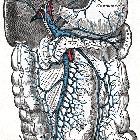transjugular intrahepatic portosystemic shunt

Transjugular
intrahepatic portosystemic shunt • Transjugular intrahepatic portosystemic shunt (TIPS) - Ganzer Fall bei Radiopaedia

Transjugular
intrahepatic portosystemic shunt • Transjugular intrahepatic portosystemic shunt (TIPS) - Ganzer Fall bei Radiopaedia

Portal vein
• Portal vein anatomy - Ganzer Fall bei Radiopaedia

Transjugular
intrahepatic portosystemic shunt • Transjugular intrahepatic portosystemic shunt (TIPS) occlusion - Ganzer Fall bei Radiopaedia

Transjugular
intrahepatic portosystemic shunt • Transjugular intrahepatic portosystemic shunt (TIPSS) - Ganzer Fall bei Radiopaedia

Transjugular
intrahepatic portosystemic shunt • Transjugular portosystemic shunt insertion - Ganzer Fall bei Radiopaedia

Transjugular
intrahepatic portosystemic shunt • Left hepatohydrothorax without ascites in a case of cirrhosis, portal hypertension and splenomegaly - Ganzer Fall bei Radiopaedia

Transjugular
intrahepatic portosystemic shunt • Transjugular intrahepatic portosystemic shunt (TIPS) - Ganzer Fall bei Radiopaedia

Transjugular
intrahepatic portosystemic shunt • Pleural calcifications - Ganzer Fall bei Radiopaedia
Transjugular intrahepatic portosystemic shunt (TIPS) is a treatment for portal hypertension in which direct communication is formed between a hepatic vein and a branch of the portal vein, thus allowing some proportion of portal flow to bypass the liver. The target portosystemic gradient after TIPS formation is <12 mmHg.
Indications
- acute variceal bleeding when pharmacologic therapy and endoscopic sclerotherapy have failed
- recurrent variceal bleeding (as a preventative procedure)
- ascites refractory to medical management in patients that require frequent drainage or do not tolerate repeated drainage
- hepatic hydrothorax that cannot be adequately managed with salt restriction and diuresis
- portal hypertensive gastropathy
- hepatorenal syndrome
- lower gastrointestinal and stomal varices
- malignant compression of hepatic or portal veins
- Budd-Chiari syndrome of moderate level disease not responsive to anticoagulation
Contraindications
Absolute contraindications
It is arguable that there are no absolute contraindications . However, practices among interventional radiologists vary. Some generally accepted absolute contraindications are :
- severe chronic liver disease or rapidly progressive acute liver failure, as the diseased or injured liver may not tolerate the diversion of nutrient portal blood flow
- severe encephalopathy resistant to medical management, as diversion of unfiltered blood will worsen it
- severe right heart failure as the flow diversion from TIPS will increase pre-load
- uncontrolled sepsis as there is a substantially increased risk of stent infection
Relative contraindications
- right heart failure
- cavernous transformation of the portal vein
- cystic hepatic disease
- occlusive main portal vein thrombus
- polycystic kidney disease
- hepatic malignancy or hemangioma
Procedure details
Complications
Acute complications
- hemorrhage (hemoperitoneum, intrahepatic hematoma, subcapsular hematoma)
- hepatic infarction
- gallbladder puncture
- sepsis secondary to infection
- vascular access sites hematoma
- unintentional arterial access
- acute kidney injury
Long-term complications
- uncontrollable hepatic encephalopathy
- recurrence of portal hypertension with sequelae
- hepatic venous stenosis
- stent occlusion: portovenogram with re-stenting is indicated when there is recurrent bleeding and decreased Doppler flow on follow-up
- stent migration
- stent infection
* Since the introduction of PTFE (polytetrafluoroethylene) stents, stent-related complications are extremely rare .
Methods to assess patency
- color Doppler
- CT angiography
- portography with portal manometry
See: TIPS evaluation.
Factors affecting poor survival
These include :
- hyponatremia
- hyperbilirubinemia
- elevated serum ALT
- advanced liver disease
- coexisting renal insufficiency
See also
Siehe auch:
- Leber
- portosystemische Umgehungskreisläufe
- Vena portae
- portale Hypertension
- Aszites
- Budd-Chiari-Syndrom
- Interventionen an Leber / Gallenwegen
- TIPS-Thrombose
- problems of TIPS
- portal-hypertensive Gastropathie
und weiter:
- kavernöse Transformation Pfortader
- Fundusvarizen
- transjuguläre Leberbiopsie
- intrahepatische Shunts
- intrahepatischer portosystemischer Shunt
- splenorenaler Shunt
- TIPS revision in late TIPS failure due to venous stenosis
- problems of TIPS - Potentially dangerous portal puncture site
- transjugular intrahepatic portosystemic shunt in partially thrombosed portal vein

 Assoziationen und Differentialdiagnosen zu transjugulärer intrahepatischer portosystemischer Shunt:
Assoziationen und Differentialdiagnosen zu transjugulärer intrahepatischer portosystemischer Shunt:





